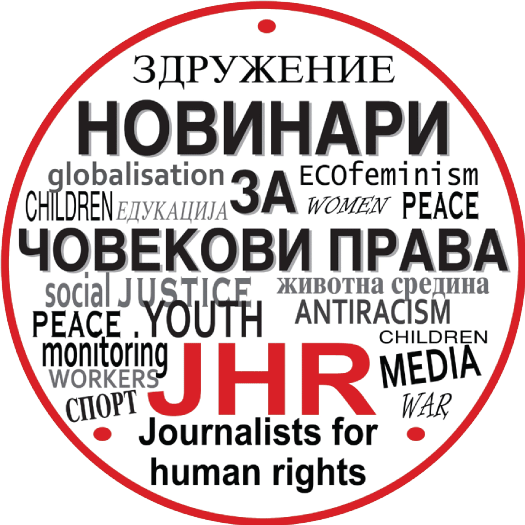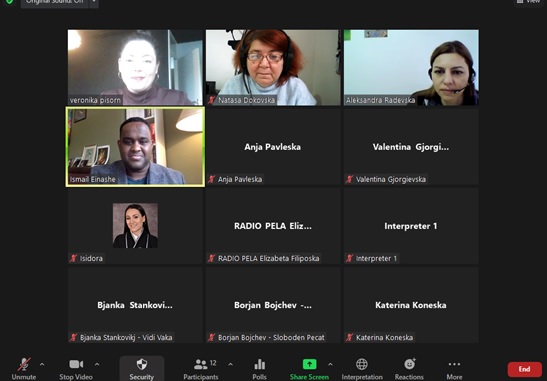За новинарите во Северна Македонија се одржа тренинг за градење капацитети за борба против трговијата со деца со обучувачите Вероника Пишорн и Иара Де Вит од „Одбрана за деца“ (Defence for children) – ECPAT, Холандија и Наташа Доковска од Северна Македонија, како и искуството што го сподели Исмаил Еинаше од истражувачката мрежа Изгубени во Европа (Lost in Europe).
Вероника Пишорн зборуваше за нерегуларната миграција, шверцот и трговијата со луѓе, споделувајќи многу податоци и ресурси за новинарите, како што се Принципите и упатствата на УНИЦЕФ за етичко известување за деца и млади под 18 години, како и врски со статистика за деца во движење. во Северна Македонија, наведувајќи дека земјата има најголем број пристигнувања во регионот (статистички податоци за 2017 година), а потоа следат БиХ и Србија. Интересно за Северна Македонија е тоа што 50 отсто од пристигнувањата доаѓаат директно од Грција, но повеќето од нив не поднесуваат барање за азил, туку транзитираат. Како добар новинарски ресурс, таа спомена некои детали од Алтернативниот извештај на НВО за состојбата со правата на децата во Северна Македонија. Притворањето на децата како сведоци во постапките против трговците со луѓе без да бидат информирани за причините за притворот, е чин на казнување на детето наместо насилникот, објасни таа, кршејќи го нивното право на информирање, дополнително ги турка да не му веруваат на системот. Таа објасни на што се однесуваат нередовна миграција, баратели на азил, бегалци, малолетни лица без придружба, шверц, трговија со луѓе, мешани миграциски текови. Како што објасни таа, шверцот станува трговија кога децата се експлоатираат.
Иара де Вите зборуваше за празнините во заштитните механизми и зголемениот ризик, како и за заштитата на децата Роми во Холандија. Како што рече, постои двојна ранливост за малолетниците без придружба да станат жртви на трговија со деца бидејќи тие често се илегално во земјата, во Холандија има законски старател обезбеден од организација за заштита на децата, што малку помага во правната заштита. има засолништа/безбедни згради за жртви на трговија со луѓе, но има недостаток на информации (поради јазикот, разбирањето, неинформираните деца). Таа го спомна истражувањето што го направиле со соработниците во Европа за ризиците од трговија при миграција во ЕУ. Оттогаш, таа ја промовира идејата дека и децата без семејство кои џепарат можат да бидат жртви на трговија со луѓе, како дел од мрежа.
Наташа Доковска го сподели примерот кога НЧП го формираше првото прифатилиште за деца на улица кон крајот на 1990-тите. Како што напомена, децата не биле на училиште, гладни и добиле можност да се образуваат и да се хранат во прифатилиштето, вклучувајќи ги и мајките да им готват и да им чистат и да добиваат плата за да не треба да питачат на улица. Но, бидејќи тоа беше едногодишен проект, децата се вратија на улица по завршувањето на истиот. Од новинарски аспект, таа рече дека треба да имаме поголемо влијание за да се подобри животот на децата Роми, да деме коректори на општеството, да има трајни промени.
Вероника Пишорн го коментираше и прашањето за одговорноста и одговорот на медиумите потсетувајќи дека прашањето за исчезнати 10.000 деца во Европа е статус кво од пред десет години. Така, податоците споделени неодамна се исти како и пред пет години и ништо не е подобрено, а дел од проблемот со исчезнатите деца мигранти и поврзано со децата Роми во Северна Македонија, е што го земаме здраво за готово. Тешко е да се натераат креаторите на политиката да ја видат ситуацијата што се случува веќе 10 години како итна – тоа не е број еден на нивната агенда за следните 5 години, но новинарите треба да се залагаат прашањето за децата Роми да стане прашање за децата воопшто.
За прашањето за заштита на ранливите луѓе таа посочи дека тоа значи како зборуваме со ранливите луѓе, но и како зборуваме за нив, а детската перспектива ја сподели во Алтернативниот извештај за состојбата со правата на децата во Македонија каде што се вели: „Новинарите кои понекогаш известуваат на новите онлајн платформи за сексуална злоупотреба на деца, во никој случај не смеат да даваат лични податоци за лицето кое станало жртва на насилство. Ова важи и за родителите; тие исто така не смеат да споделат дека нивното дете било жртва на сексуална злоупотреба, освен ако детето не се согласи на тоа“.
Иара де Вит, објаснувајќи зошто зборовите се важни, се повика на Терминолошките упатства за заштита на децата од сексуална експлоатација и сексуална злоупотреба (Луксембуршки упатства, 2016). Како што рече, во ECPAT се чувствувало дека зборовите се важни бидејќи дефинира како ги конципираме проблемите, ги дефинираме прашањата и реагираме. Не треба да се толерира тенденцијата да се користи јазикот што ги прави децата актер во сопствената злоупотреба, а преку овие упатства завршени во 2016 година сакавме да го постигнеме тоа, објасни таа.
Наташа Доковска осврнувајќи се на македонската перспектива за известување сподели некои детали за законската регулатива за трговија со луѓе и деца, додавајќи дека Националната комисија за борба против трговија со луѓе е одговорен за преземање мерки насочени кон подобрување на идентификацијата на жртвите на трговија со луѓе, обезбедување нивна помош и заштита, како и поефикасно откривање на сторителите на трговија со луѓе и нивно изведување пред лицето на правдата. Таа сподели некои основни принципи кои треба да се следат, наведувајќи дека добро обучениот новинар: не го цени премногу својот производ, се воздржува да дава сопствено мислење кога известува, користи наводници и наведува извори, е опседнат со вистината, служи на граѓани, е скептик (а често и критичар), има страст за новинарство, го знае проблемот што го третира.
Зборувајќи за етиката во известувањето во македонските медиуми, таа напомена дека е важно да не се прави сензација и да се следат парите (кој е трговецот, синџирот итн.) Многу е важно да не се користи говор на омраза или стереотипи, но и да се хуманизира приказната, но и да не се прави секундарна виктимизација, поставувајќи постојано исти прашања. Проверката на изворите е исто така многу важна, како и да не се открие идентитетот на жртвата и да се почитува жртвата и нејзините права.
Исмаил Ајнаше на сесијата за пронаоѓање и истражување на приказни го сподели своето искуство со мрежата Изгубени во Европа и новинарство информирано за траума при третирање на миграција. Тој даде преглед за тоа како новинарите можат поефикасно да известуваат за ранливите луѓе кои доживеале траума, истражувајќи ја улогата на новинарите и медиумите во присилната миграција и нејзините последици, разбирајќи како некои приказни за бегалците можат да направат повеќе штета отколку корист, како да се избегнат стереотипите, клишеа и пропаганда, како да се користи методологијата за известување, раскажувањето приказни и интердисциплинарните соработки, како да се вратат алатките на бегалците и мигрантите за да ги раскажат своите приказни по нивни услови, како и она што медиумите грешат за покривањето на прашањата за миграцијата и бегалците. Како корисен извор го спомна Дарт центарот за новинарство и траума, и совети за вклучување на децата и семејствата во известувањето, како и Стилскиот водич за новинарство информирано за траума, во кое тој помогна, со одлични референци за јазикот и терминологијата, како и етика во известувањето за теми како што се нерегуларна миграција, трговија со луѓе, шверц на луѓе итн.
Тој напомена дека навистина е важно да се има „информирана согласност“, што значи дека интервјуираниот треба да знае какви се последиците за него ако излезе приказна и биде препознаен како „свиркач“, што значи тоа за нивното семејство , особено во контекст на децата. Кога луѓето кои се ранливи треба да не бидат дополнително загрозени, со откривање на идентитетот, местото или да не знаат какви би можеле да бидат последиците врз нив. Како што рече Ајнаше, кога разговарате со луѓе кои доживеале траума, треба да бидете подготвени за невообичаени текови на разговори и да бидете флексибилни. Кадрирањето е критично, внимавајте дека новинарите имаат свои културни објективи, обидете се да ги избегнувате културните стереотипи (на пример за ромската заедница) и ако користите преведувач, бидете сигурни дека тие се информирани за траума.
Разговарајќи за тоа што е траума, учесниците ја дефинираа како емоционален одговор на страшен настан, повреда различна од физичка рана која се чувствува како последица на учество со трагичен крај, но и како неверојатно, необично изненадување, обично преку визуелна перцепција. Вероника Пишорн додаде дека не сите трауми изгледаат исто, и не сите реакции изгледаат исто.
И покрај тоа што медиумите ќе кажат дека имаат, нема вистински тренинзи за траума во медиумските куќи воопшто, но има многу ресурси и надворешни обуки кои можат да помогнат, како и разговор со колеги кои биле во слична ситуација на известување.
Беше посочено дека обуката беше добра можност за споделување искуства, но и шанса за продолжување на соработката, правење приказни и поврзување со колегите од регионот, евентуално приклучувајќи се на некои новинарски истражувачки проекти на оваа тема, како и дополнително развивање на знаењето за известување, подигање на свеста и придонес за заштита на децата од трговија со луѓе.

